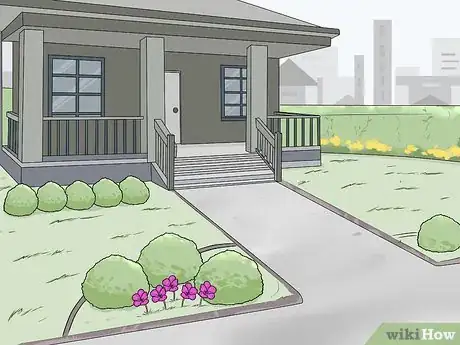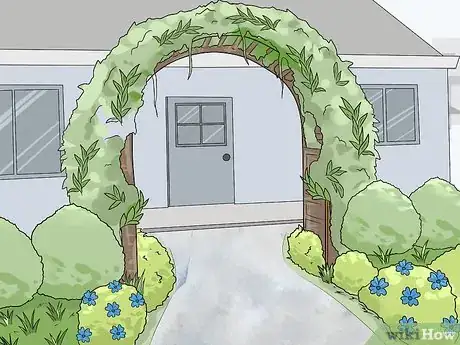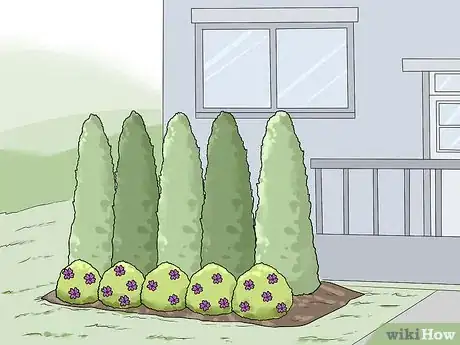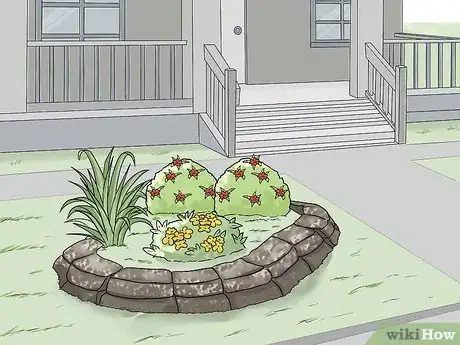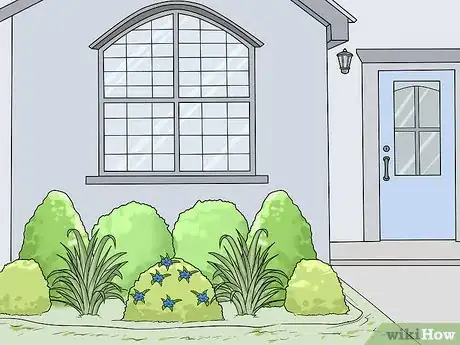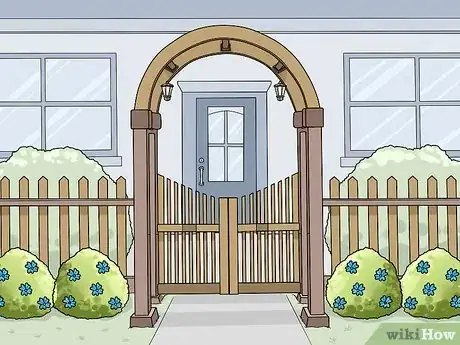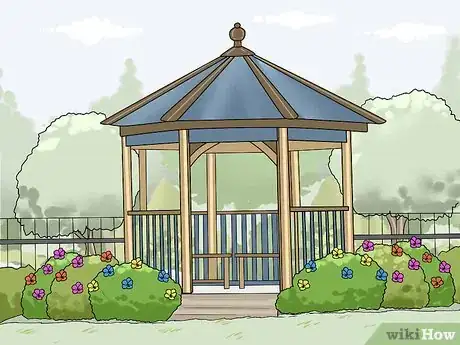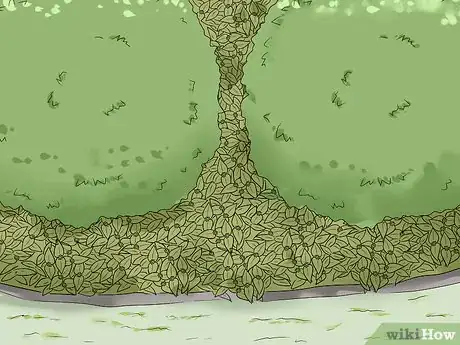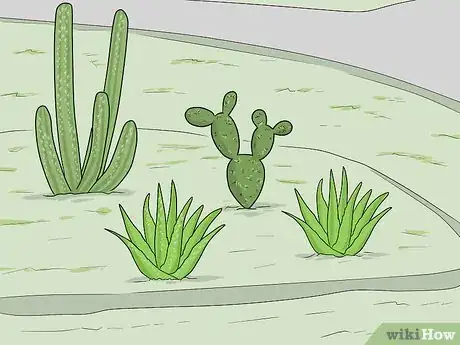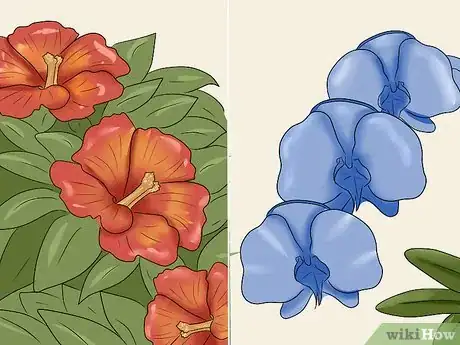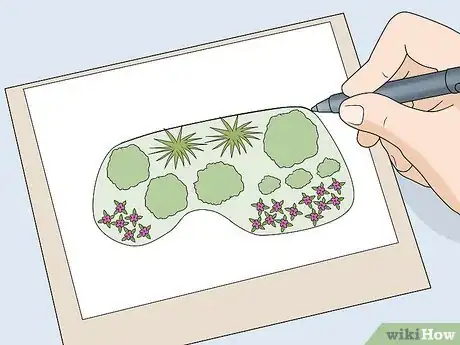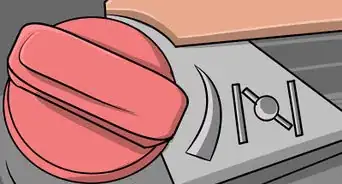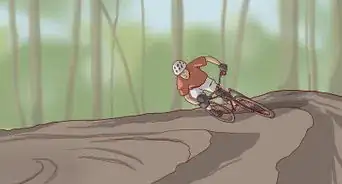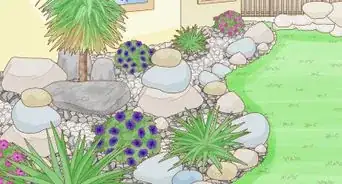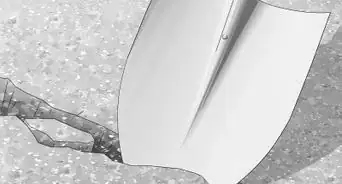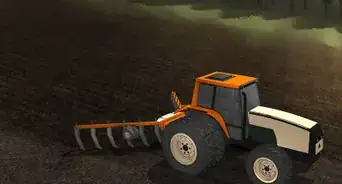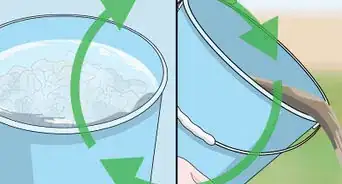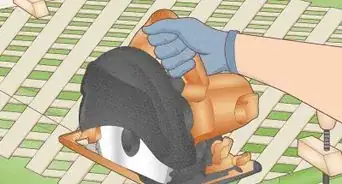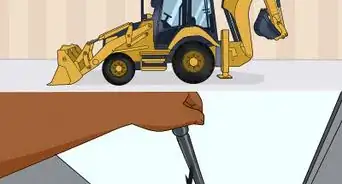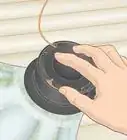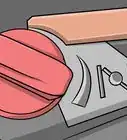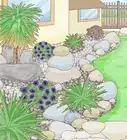This article was co-authored by Sina Kamran and by wikiHow staff writer, Eric McClure. Sina Kamran is a Hardscaping Specialist and the Owner of Design Scapes, Inc. in Santa Monica, California. With over 15 years of experience, he specializes in customized, site-specific hardscaping and landscaping design/build projects. He's a certified National Concrete Masonry Association (NCMA) designer, a certified installer with the Interlocking Concrete Pavement Institute (ICPI), and a Rain Bird Certified Irrigation Professional. Additionally, Design Scapes, Inc. has many 5-star rated reviews.
There are 18 references cited in this article, which can be found at the bottom of the page.
This article has been viewed 13,054 times.
Designing a front yard can feel overwhelming at first, but the wide array of options is simply an opportunity to express yourself and create something truly unique. To start, select a design philosophy to guide your decisions. Choosing between a modern, traditional, or naturalistic design will help streamline the process significantly. Once you have a general idea of where you want to place plants and structures, select specific species to plant in your yard. As a rule of thumb, larger plants should be placed closer to your home while shorter foliage goes closer to the edge of your yard. Sketch out your features and plants using tracing paper to get a sense for where you want to place everything.
Steps
Choosing a Design Philosophy
-
1Use grass and small shrubs to design a traditional, simple yard. If you want a simple, traditional yard, stick with grass, simple shrubs, and basic bushes. Stick with 1-2 varieties of flower, or skip them altogether. Choose this option if you want to minimize the amount of effort you need to put into maintenance or don’t want to stand out on your block.[1]
- This is also a great option if your current yard has nothing in it. You can always build on a basic yard later as you save money for renovation costs or develop new ideas for your yard.
- Keeping your yard relatively simple is a great idea if you have children or pets, since you won’t need to worry as much about anyone stomping on precious plants or fragile structures.
-
2Utilize a lot of shrubs, flowers, and vines to create a natural look. If you want to feel like you’re entering a greenhouse when you’re walking up to your front door, reserve lots of space in your yard for various plants, flowers, and shrubs. Cover mailboxes or light fixtures with vines and use garden gates to make it seem like your yard is a brand new world.[2]
- Keep in mind, you’ll need to put a lot more effort into your yard if you plant a ton of greenery.
- This may not be the best option if you live in an area prone to droughts. If you don’t have a steady supply of water, your yard will naturally degrade into compost over time.
Advertisement -
3Match the architectural features of your home for a cohesive look. If you have a narrow 3-story home, utilize a lot of tall plants to match the verticality of your home. If your home is a ranch-style building with a single floor, plant dwarf shrubs and bushes to complement the shape and style of the architecture. Utilizing structures and plants that match the architectural style of your home will ensure that nothing looks out of place or seems off.[3]
- You can break this guideline if you want to emphasize the yard over your home by planting larger, more unique plants. If you want to emphasize your home over the yard, keep the landscape simple and streamlined.
-
4Skip plants altogether and use stones for a more modern look. If you live in a modern building or don’t have much yard space, feel free to skip greenery altogether. You can hire a contractor to install a pattern of stones or load your front yard with gravel. This is also a great choice if you don’t want to worry about maintaining plants or live somewhere with extreme shifts in temperature that tend to destroy a lot plants.[4]
- This is a great option if you live in a city and don’t have an enclosed yard, since you won’t need to worry about strangers trampling all over your greenery.
- Skipping plants is also a great choice if you live in an arid climate that doesn’t get much rain.
Including Larger Structures
-
1Keep your windows and doors clear of obstructions. Natural light goes a long way when it comes to creating good vibes in your home. Avoid blocking windows with tall shrubs or plants to ensure that your windows stay clear. Keep wild plants and furniture 3–5 feet (0.91–1.52 m) away from the sides of your door to avoid blocking it. Restricting the door will make it hard for people to identify the focal point of your yard.[5]
Tip: When looking at a building, most people naturally look at the door before inspecting any other elements in your yard. Designing the rest of your yard around your door is a great way to guide design decisions if you aren’t sure what you’re looking for in a front yard.
-
2Place garden gates on the same plane as your front door. A garden gate is a doorframe or overhang that separates your front yard from your backyard. If your front yard is enclosed, put a garden gate in front of your front door to create a beautiful symmetry for your front yard. If the front yard is open, place a garden gate on the same horizontal plane as your front door on one of the sides of your building.[6]
- A garden gate leading into your front door is a great way to make your front yard feel like a distinct, separate space.
- A garden gate on the side of your home will function as a clear divider for guests and bystanders. This will create a heightened sense of privacy.
- You do not need to include a garden gate if you don’t want to.
-
3Set space aside for seating if you want to sit and enjoy your yard. If you plan on spending a lot of time outside, don’t forget about benches and lawn furniture. Consider how many people you live with and how often you have guests over to determine how much seating you need. Set up benches, rocking chairs, and outdoor furniture in shady areas of your yard to stay cool on hot summer days.[7]
- Avoid setting up seating that isn’t capable of being locked up if you live in a city. A simple chain lock will work to deter opportunistic thieves in most cases.
- While umbrellas are great for creating shade in a backyard, they tend to take up a ton of space in a front yard. Avoid using one unless you have no nearby trees or overhangs.
-
4Keep gazebos and sheds in your backyard if you can. For really big structures that take up a lot of space, opt to place them in your backyard. The front yard is the public’s first impression of your home, and a large shed or gazebo will obscure a large portion of your home from the street. If you need storage space for gardening materials, set up a small storage box on the side of your home.
-
5Check with your city before adding architectural features. If you want to install a fire pit, walkway, or driveway, contact your local building office before beginning work to ensure that you aren’t violating any city codes. If you are found to be in violation, you will be fined and force to stop construction.[8]
-
6Make your walkways obvious to avoid confusion. If you’re installing a brand new walkway, avoid winding paths and don’t place large plants along your walkway to keep things clear. Use guide lights to line your walkway with small bulbs to make it easier to see where you’re going at night. Consider lining both sides of your walkway with gravel to create a barrier between guests and the plants in your yard.[9]
- You can use separate slabs of limestone instead of concrete for your walkway if you want to create a unique, modern vibe in your yard.
- You can use fine gravel instead of concrete or stone if you don’t live in a particularly busy or windy area.
-
7Plant flowers and small shrubs around the bases of fences and porches. While larger shrubs and bushes look great along the foundation of your building, you don’t want to obscure fences and porches entirely. Use smaller flowers or bushes to line the area where the yard meets the structure. Wildflowers, orchids, and cacti can all work well as border plants to create some texture between the porch, fence, and yard.[10]
- Leave at least 6 inches (15 cm) of space between the bases of fences and porches and the flowers you line them with.
- If you’re going for a more modern look or your fence and porch are unique, consider lining the surrounding space with gravel or loose stones instead.
- For a more natural look, plant vines or ivies along the porch or fence. As they grow, they will make their way up the fence and porch to give it a rustic look..
Selecting Your Plants
-
1Place taller plants in the back to create a natural buildup to your building. When considering the location of each plant, place taller specimen closer to the foundation of your home and work in a descending order away from your home. This will ensure that your yard feels natural and that every plant remains visible from the front of your yard.[11]
- Feel free to break this philosophy if you want to create a more chaotic, naturalistic-looking yard.
Tip: Placing taller plants near the foundation of your home will also hide your crawl space if you have one. Even if you don’t though, placing large plants near your foundation will soften the sharp angle where your building meets the yard.
-
2Plant evergreen or deciduous bushes and shrubs near your foundation. For your shrubs and bushes, select deciduous or evergreen plants that don’t easily wilt or die in harsh weather. Boxwood, inkberry, and holly are all excellent choices for the area near your foundation since they require little work when it comes to maintenance.[12]
- Foundation plants should be placed at least 4–6 feet (1.2–1.8 m) away from the building to ensure that the roots don’t grow into your foundation. This will also make it easier to access the exterior walls of your home.
- For more colorful options, Girard’s Rose bushes, azalea, and chokeberry are fun choices. Japanese barberry is a great choice if you want a shorter bush that grows in wild directions.
- Korean boxwood is a great choice if you prefer small-leaved shrubs that can be cut into unique geometric shapes.
- Most evergreen and deciduous bushes grow in a variety of climates. Evergreen varieties are particularly good for colder climates.
- Remember, though, that there's really no such thing as low-maintenance when it comes to gardening. Shrubs might end up growing and you need to be ready to deal with them.
-
3Select resilient flowers based on your climate. Perennial flowers that will bloom for longer periods of time are the best choice if you want to avoid wilting flowers and dead plant matter in your yard. Aster is a great choice if you want a flower that blooms late into the fall and comes in a variety of colors. Peonies are excellent flowers that can live for decades in the right climate. Choose resilient species on their colors and shapes.[13]
- Make sure that you only plant flowers that succeed in your climate. Look each potential flower up online or ask the clerk at your local flower nursery to figure out what will grow well in your area.
- Delphinium is a great choice if you’re looking for vertical flowers that grow taller than normal flowers.
-
4Use ground cover plants to hide problematic areas of your yard. Ground cover refers to flowers and shrubs that grow freely over large areas of soil and grass. Ground cover is an excellent option if you want to create some variety in your yard between the standard flowers, larger shrubs, and the flatter grass. Asian jasmine is one of the most popular choices of all time, and English ivy is a great choice if you want vines to climb up nearby trees, walls, and structures.[14]
- Deadnettle is a solid choice for a flower that functions as ground cover since it’s quite resilient and sticks around for a longer period of time.
- Another option for ground cover is horse herb, which blooms small, yellow flowers year round.
- Mondograss is a great choice if you want a messy-looking plant that can grow wildly across your yard. It also tends to do well in colder climates.
- Flowering ground cover plants will succeed in a variety of climates, but they will struggle in colder climates after the first freeze of the year.
-
5Opt for cacti and desert succulents if you live in an arid climate. In drier areas, plants that require a lot of water will struggle to grow. Cacti, like Claret Cup, Ocotillo, and Prickly Pear are great choices that can add a lot of color to your yard. Yucca varieties are an excellent option if you want a more traditional-looking cactus. Lechuguilla, agave, Echeveria, and Jade are phenomenal choices for smaller succulents that won’t take up much space.[15]
- While they aren’t technically flowers, cacti are great choices that can live for an incredibly long time without water.
-
6Select gingers, hibiscus, or orchids if you live in a tropical area. Tropical plants require very little attention so long as it rains regularly. Gingers, like Alpina and Kaempferia are hearty plants that will add a lovely aroma to your garden. Orchids are perhaps the most popular tropical flower. They come in a variety of colors. They are resilient and flower for a long period of time. Hibiscus is a great choice for shadier and less humid climates.[16]
- If you’re planting flowers around trees in your garden, Epiphytes are popular plants that can grow in the bark of trees.
Sketching a Landscape Design
-
1Create a basic outline of the shape of your yard. To start, grab a sheet of paper and draw a basic outline of your yard. You can measure the dimensions of your yard and use graph paper to create a scale drawing, but this isn’t necessary for preliminary sketches. This process is more about choosing locations and shapes than placing structures and plants in specific locations.[17]
- Do this on a sheet of paper larger than 9 by 11 inches (23 by 28 cm) to give yourself plenty of room to work. Keep it smaller than 36 by 42 inches (91 by 107 cm) though, since too much space will make it hard to keep your drawing consistent.
Tip: Design companies typically perform this service for you, but you should sketch your desired layout even if you aren’t doing the work yourself. It will be helpful to refer to your illustration when you’re trying to explain what you want to the contractors.
-
2Draft multiple designs to develop a style that works for you. Get a roll of tracing paper and cut out a sheet as large as your original outline to give yourself enough room to work. Cut a few sheets to size and sketch different possible layouts for your landscaping features. Play around with symmetrical and asymmetrical designs. Draw where you want to place your shrubs, bushes, and flowers. If your walkways don’t exist yet, sketch out where you want to put them.[18]
- You don’t need to know exactly what type of plant you’re going to put in each space, but it’s a good idea to have a sense for the type of look you’re going for.
- Label each shape that you draw so that you can easily keep track of what everything is going to look like. For example, you may draw larger rectangles and label them “shrubs” followed by smaller circles that are labeled “flowers.”
- Unless your yard is oddly shaped, it’s best to keep walkways simple. Going straight from the sidewalk to your door will minimize the amount of space that your walkway takes up while making it easier to navigate at night.
- It’s a good idea to leave at least 50% of your yard empty. A little negative space is important and you may want room to exercise or walk around.
-
3Select your favorite design and redraw the design with more detail. Set each of your possible layouts out next to one another to get a better sense of what you like. Once you’ve selected a layout, lay your chosen design out over the outline of the yard and put a new sheet of tracing paper on top. Re-sketch your layout and pay more attention to the lines that you draw to give each feature a more defined shape. Add individual stones, walkways and textures to give your drawing a greater sense of detail.[19]
- You may realize as you’re adding more details that your design is too busy, empty, or that something is improperly placed.
- For example, draw squiggly lines around your shrubs to give them some texture, draw small flowers together to get a sense for the texture of your garden. Add individual stones or concrete squares to give your walkway its shape.
-
4Color in your drawing to get a sense for the visual impact of your design. Use a green pencil or marker to shade in grass and use a darker green for shrubs and bushes. Select colors for your flowers based on the colors that you plan on planting. Use a brown or black to color in planter boxes or designated areas for soil. Use gray or beige for your walkways and driveway. This will make it easier to visualize where everything belongs when it comes time to put your sketch into practice.[20]
- Again, your sketch doesn’t need to be perfect. Things can change as you go about discussing options with landscaping contractors or consultants. If you’re doing your own landscaping, you may deviate from your outline once you realize that certain things need to be changed.
Expert Q&A
-
QuestionHow do you landscape a hill in your front lawn?
 Sina KamranSina Kamran is a Hardscaping Specialist and the Owner of Design Scapes, Inc. in Santa Monica, California. With over 15 years of experience, he specializes in customized, site-specific hardscaping and landscaping design/build projects. He's a certified National Concrete Masonry Association (NCMA) designer, a certified installer with the Interlocking Concrete Pavement Institute (ICPI), and a Rain Bird Certified Irrigation Professional. Additionally, Design Scapes, Inc. has many 5-star rated reviews.
Sina KamranSina Kamran is a Hardscaping Specialist and the Owner of Design Scapes, Inc. in Santa Monica, California. With over 15 years of experience, he specializes in customized, site-specific hardscaping and landscaping design/build projects. He's a certified National Concrete Masonry Association (NCMA) designer, a certified installer with the Interlocking Concrete Pavement Institute (ICPI), and a Rain Bird Certified Irrigation Professional. Additionally, Design Scapes, Inc. has many 5-star rated reviews.
Hardscape Specialist Make sure that you're taking care of the soil and the erosion problems! The best way to do that is by planting good spreading types of plants so the root system will hold the soil together (and stop it from erosion). Also, use some sort of shredded mulch to slow down the water from first eroding into the hillside. If the slope is really steep, you can include a tree or 2 in there as well.
Make sure that you're taking care of the soil and the erosion problems! The best way to do that is by planting good spreading types of plants so the root system will hold the soil together (and stop it from erosion). Also, use some sort of shredded mulch to slow down the water from first eroding into the hillside. If the slope is really steep, you can include a tree or 2 in there as well.
Expert Interview

Thanks for reading our article! If you'd like to learn more about landscaping a front yard, check out our in-depth interview with Sina Kamran.
References
- ↑ https://www.bobvila.com/slideshow/12-expert-tips-for-eye-catching-front-yard-landscaping-47571#planting-trees-in-front-yard
- ↑ https://www.bhg.com/gardening/design/styles/21-easy-ideas-to-beautify-your-yard/
- ↑ https://www.finegardening.com/article/matching-the-colors-of-your-house-and-garden
- ↑ https://www.bobvila.com/slideshow/pass-on-grass-7-reasons-to-landscape-with-gravel-48106#blue-glass-gravel-landscaping
- ↑ https://www.bobvila.com/slideshow/12-expert-tips-for-eye-catching-front-yard-landscaping-47571#planting-trees-in-front-yard
- ↑ https://www.bobvila.com/slideshow/great-entrances-10-welcoming-garden-gates-47556
- ↑ https://www.bhg.com/home-improvement/patio/designs/8-tips-patio-furniture/
- ↑ http://www.cerritos.us/RESIDENTS/_pdfs/residential_front_yard_landscape_design_manual.pdf
- ↑ https://www.bobvila.com/slideshow/12-expert-tips-for-eye-catching-front-yard-landscaping-47571
- ↑ https://www.southernliving.com/garden/flowers/best-flowers-for-fence-video
- ↑ https://www.thisoldhouse.com/ideas/best-foundation-plants-stellar-curb-appeal
- ↑ https://www.missouribotanicalgarden.org/gardens-gardening/your-garden/help-for-the-home-gardener/advice-tips-resources/visual-guides/best-shrubs.aspx
- ↑ https://www.countryliving.com/gardening/garden-ideas/advice/g1143/best-perennials-for-any-yard/
- ↑ https://www.bobvila.com/slideshow/12-expert-tips-for-eye-catching-front-yard-landscaping-47571#planting-trees-in-front-yard
- ↑ https://www.nps.gov/whsa/learn/nature/cacti.htm
- ↑ https://aggie-horticulture.tamu.edu/galveston/publications/Creating-the-Tropical-Look.pdf
- ↑ https://youtu.be/f4HAmuBmJms?t=36
- ↑ https://youtu.be/f4HAmuBmJms?t=48
- ↑ https://youtu.be/f4HAmuBmJms?t=75
- ↑ https://youtu.be/f4HAmuBmJms?t=158
